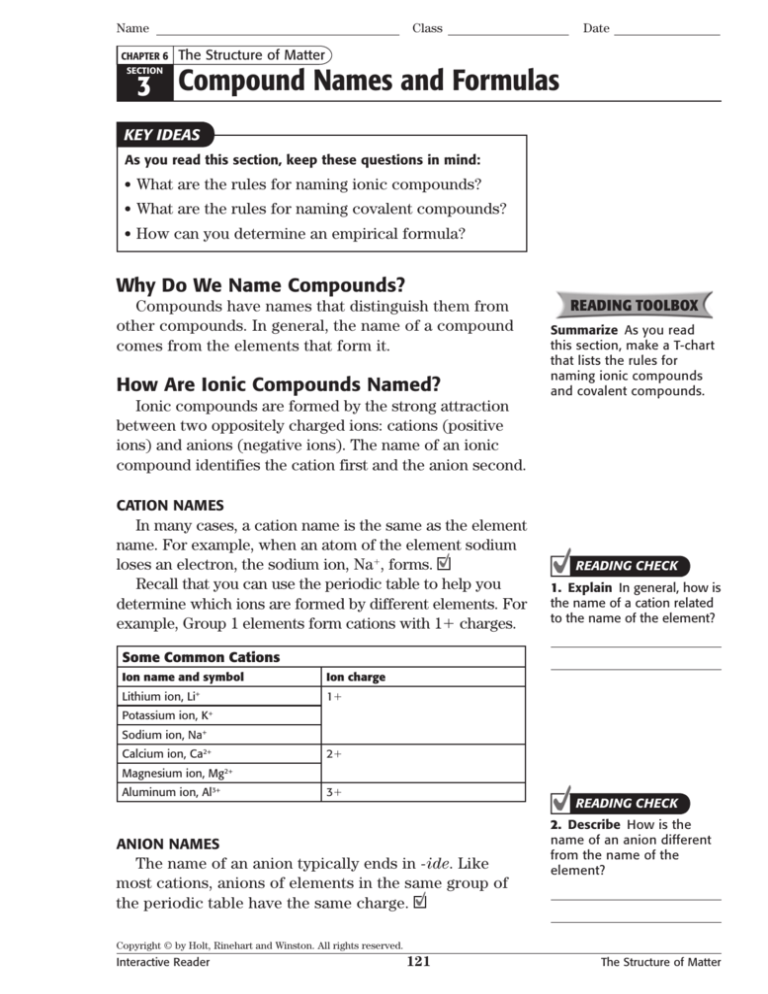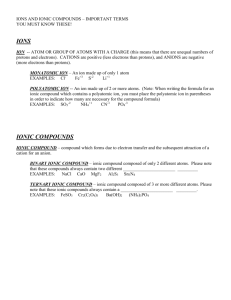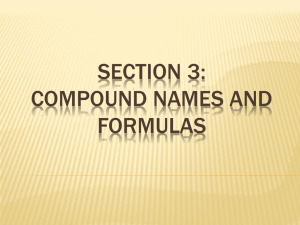
Name
CHAPTER 6
Class
Date
The Structure of Matter
SECTION
3 Compound Names and Formulas
KEY IDEAS
As you read this section, keep these questions in mind:
• What are the rules for naming ionic compounds?
• What are the rules for naming covalent compounds?
• How can you determine an empirical formula?
Why Do We Name Compounds?
Compounds have names that distinguish them from
other compounds. In general, the name of a compound
comes from the elements that form it.
How Are Ionic Compounds Named?
READING TOOLBOX
Summarize As you read
this section, make a T-chart
that lists the rules for
naming ionic compounds
and covalent compounds.
Ionic compounds are formed by the strong attraction
between two oppositely charged ions: cations (positive
ions) and anions (negative ions). The name of an ionic
compound identifies the cation first and the anion second.
CATION NAMES
In many cases, a cation name is the same as the element
name. For example, when an atom of the element sodium
loses an electron, the sodium ion, Na, forms.
Recall that you can use the periodic table to help you
determine which ions are formed by different elements. For
example, Group 1 elements form cations with 1 charges.
READING CHECK
1. Explain In general, how is
the name of a cation related
to the name of the element?
Some Common Cations
Ion name and symbol
+
Lithium ion, Li
Ion charge
1
Potassium ion, K+
Sodium ion, Na+
Calcium ion, Ca2+
2
2+
Magnesium ion, Mg
Aluminum ion, Al3+
3
READING CHECK
ANION NAMES
The name of an anion typically ends in -ide. Like
most cations, anions of elements in the same group of
the periodic table have the same charge.
2. Describe How is the
name of an anion different
from the name of the
element?
Copyright © by Holt, Rinehart and Winston. All rights reserved.
Interactive Reader
121
The Structure of Matter
Name
SECTION 3
Class
Date
Compound Names and Formulas continued
Some Common Anions
EHHDBG@<EHL>K
3. Identify What is the
charge of a chloride ion?
Element
Ion
Ion charge
Fluorine, F
fluoride ion, F
1
Chlorine, Cl
chloride ion, Cl
Bromine, Br
bromide ion, Br
Iodine, I
iodide ion, I
Oxygen, O
oxide ion, O2
Sulfur, S
sulfide ion, S2
Nitrogen, N
nitride ion, N3
2
3
TOTAL CHARGE OF IONIC COMPOUNDS
READING CHECK
4. Identify What is the
total charge on an ionic
compound?
The sum of the charges of all of the ions in a compound
must add up to zero. Therefore, if an ionic compound has
two ions with different charges, the ratio of ions will not
be 1:1. For example, calcium fluoride contains calcium
ions, Ca2, and fluoride ions, F. For the compound to
have a total charge of zero, there must be two fluoride
ions for every calcium ion. Thus, the formula for calcium
fluoride is CaF2.
CHARGES OF TRANSITION METALS
Many transition metals can form several cations—each
with a different charge. The table below lists some common cations. For example, the compounds FeO and Fe2O3
both have iron cations, but the charges of the iron cations
are different. If you used the naming rules described so far,
you would name both of these iron oxide. However, they
are different compounds, so they need different names.
To show the difference between FeO and Fe2O3, the
charge of the iron cation is included in the name. Roman
numerals in parentheses after the cation name show the
charge on the cation. The cation in FeO is Fe2, so it is
named iron (II) oxide. The cation in Fe2O3 is Fe3, so it is
named iron (III) oxide.
READING CHECK
5. Explain What do the
roman numerals after the
cation name of a transition
metal represent?
Some Transition Metal Cations
Ion name
Ion symbol
+
Ion name
Ion symbol
Copper(I) ion
Cu
Chromium(II) ion
Cr2+
Copper(II) ion
Cu2+
Chromium(III) ion
Cr3+
Iron(II) ion
Fe2+
Cadmium(II) ion
Cd2+
Titanium(II) ion
Ti2
3+
Iron(III) ion
Fe
Nickel(II) ion
Ni2+
Titanium(III) ion
Ti3+
Nickel(III) ion
Ni3+
Titanium(IV) ion
Ti4+
Copyright © by Holt, Rinehart and Winston. All rights reserved.
Interactive Reader
122
The Structure of Matter
Name
SECTION 3
Class
Date
Compound Names and Formulas continued
DETERMINING TRANSITION METAL CHARGES
How can you tell that the iron ion in Fe2O3 has a 3
charge? Examine the total charge on the oxide ion.
An oxide ion has a 2 charge. Thus, three oxide ions
have a total charge of 6. If the total anion charge is 6,
the total cation charge must be 6. Because there are
two Fe ions in Fe2O3, each Fe ion must have a 3 charge.
8g^i^XVa I]^c`^c\
6. Apply Concepts What is
the charge on the titanium
ion in the compound TiO2?
DETERMINING FORMULAS OF IONIC COMPOUNDS
You can find the charge of each ion in a compound if
you know the compound’s formula. You can find the
formula for a compound if you know the compound’s name.
What is the chemical formula for aluminum fluoride?
Step 1: List the known and
unknown values.
Known:
aluminum ion: Al3+
Unknown:
chemical formula
fluoride ion: F
Step 2: Write the symbols for
the ions with the cation first.
Al3+, F
Step 3: Find the least common
multiple of the ions’ charges.
Write the chemical formula.
Use subscripts to show the
number of each ion needed to
make a neutral compound.
The least common multiple of 3 and 1
is 3. Three positive charges and three
negative charges are needed.
(1 3) = 3
Only one Al3+ ion is needed.
(3 1) = 3
EHHDBG@<EHL>K
7. Apply Concepts What
is the chemical formula for
beryllium chloride? Use the
steps described in the table
to help you.
Three F ions are needed.
So, the chemical formula for aluminum fluoride is AlF3.
How Are Covalent Compounds Named?
The rules for naming covalent compounds are
different from those used to name ionic compounds.
The names of covalent compounds have prefixes to
indicate how many atoms of each element are in the
molecule. The table below shows some prefixes used
to name covalent compounds.
Prefixes Used to Name Covalent Compounds
Number of
atoms
Prefix
Number of
atoms
Prefix
1
mono-
6
hexa-
2
di-
7
hepta-
3
tri-
8
octa-
4
tetra-
9
nona-
5
penta-
10
deca-
READING CHECK
8. Identify What do the
prefixes in the names of
covalent compounds tell
you?
Copyright © by Holt, Rinehart and Winston. All rights reserved.
Interactive Reader
123
The Structure of Matter
Name
SECTION 3
Class
Date
Compound Names and Formulas continued
USING NUMERICAL PREFIXES TO NAME COMPOUNDS
READING CHECK
9. Identify Which element
in a compound is named
first?
The element farthest to the left in the periodic table is
named first in a compound. If there is only one atom of the
first element, its name does not get a prefix. The element
farthest to the right in the periodic table is named second.
Its name ends in –ide.
For example, N2O4 has two nitrogen atoms and four
oxygen atoms. Nitrogen is farther to the left in the
periodic table than oxygen, so it is named first. The
name of this compound is dinitrogen tetroxide. The
a in tetra is dropped to make the name easier to say.
What Are Empirical Formulas?
An empirical formula gives the smallest
whole-number ratio of atoms in a compound. For
example, the empirical formula for water is H2O. This
tells you that the ratio of hydrogen atoms to oxygen
atoms is 2:1. For most ionic compounds, the empirical
formula is the same as the chemical formula. However,
for many covalent compounds, the empirical and
chemical formulas are different.
One mole of a compound contains 62 g of phosphorus
and 80 g of oxygen. What is the empirical formula of this
compound?
Step 1: List the given and
unknown values.
Given:
Mass, m of
phosphorus:
62 g
Unknown:
empirical formula
Mass, m of oxygen:
80 g
Math Skills
10. Calculate A sample
of a compound contains
160 g of oxygen and
20.2 g of hydrogen. What is
the compound’s empirical
formula?
Step 2: Write the atomic
masses.
phosphorus: 30.97 g/mol
oxygen: 16.00 g/mol
Step 3: Write the molar
ratio of the elements.
62 g P 1 mol P
_________________
2.0 mol P
The molar ratio of
30.97 g P
elements in the compound
80 g O 1 mol O
_________________
will be the compound’s
5.0 mol O
16.00 g O
empirical formula.
So, the empirical formula of the compound is P2O5.
Copyright © by Holt, Rinehart and Winston. All rights reserved.
Interactive Reader
124
The Structure of Matter
Name
SECTION 3
Class
Date
Compound Names and Formulas continued
THE SAME EMPIRICAL FORMULA
Empirical formulas only show the ratio of atoms in
a compound. They do not show the actual number of
atoms of each element that is in the compound. So, it is
possible for two different compounds to have the same
empirical formula.
For example, formaldehyde, acetic acid, and glucose
all have the empirical formula CH2O. That is, the ratio of
the atoms in each of the compounds is 1:2:1. However,
these three compounds are very different from one
another. Formaldehyde is used to preserve dead organisms. Acetic acid gives vinegar its sour taste. Glucose is a
sugar that your body uses for energy.
READING CHECK
11. Explain Why is it
possible for different
compounds to have the
same empirical formulas?
MOLECULAR FORMULAS
A molecular formula tells you how many atoms are
in one molecule of the compound. You can use the empirical formula of a compound and its molar mass to find its
molecular formula.
Compound
Empirical Molar
Molecular Structure
formula
mass
formula
(g/mol)
Formaldehyde CH2O
30.03
CH2O
/XYGEN
#ARBON
8g^i^XVa I]^c`^c\
12. Predict A particular
compound has the
empirical formula CH2O. Its
molar mass is 240.0 g/mol.
Predict the molecular
formula for this compound.
(YDROGEN
Acetic acid
CH2O
60.06
2 CH2O
C2H4O2
Glucose
CH2O
180.2
6 CH2O
C6H12O6
Copyright © by Holt, Rinehart and Winston. All rights reserved.
Interactive Reader
125
The Structure of Matter
Name
Class
Date
Section 3 Review
SECTION VOCABULARY
empirical formula a chemical formula that
shows the composition of a compound in
terms of the relative numbers and kinds of
atoms in the simplest ratio
molecular formula a chemical formula that
shows the number and kinds of atoms in a
molecule, but not the arrangement of the
atoms
1. Identify Complete the table below to identify and name several ionic compounds.
Chemical Formula
Chemical Name
Cation
Anion
Cd2
N3
CaBr2
Nickel(II) oxide
Cadmium(II) nitride
2. Identify Complete the table below to identify and name several covalent
compounds.
Chemical Formula
Chemical Name
SiI4
Dinitrogen monoxide
P4O10
3. Explain What is the charge of the cadmium ion in cadmium bromide, CdBr2?
Explain your answer.
4. Calculate One mole of an unknown sample contains 120 g of carbon and 30.3 g of
hydrogen. What is the empirical formula of the compound? Show your work.
5. Compare How does a molecular formula differ from an empirical formula?
Copyright © by Holt, Rinehart and Winston. All rights reserved.
Interactive Reader
126
The Structure of Matter







